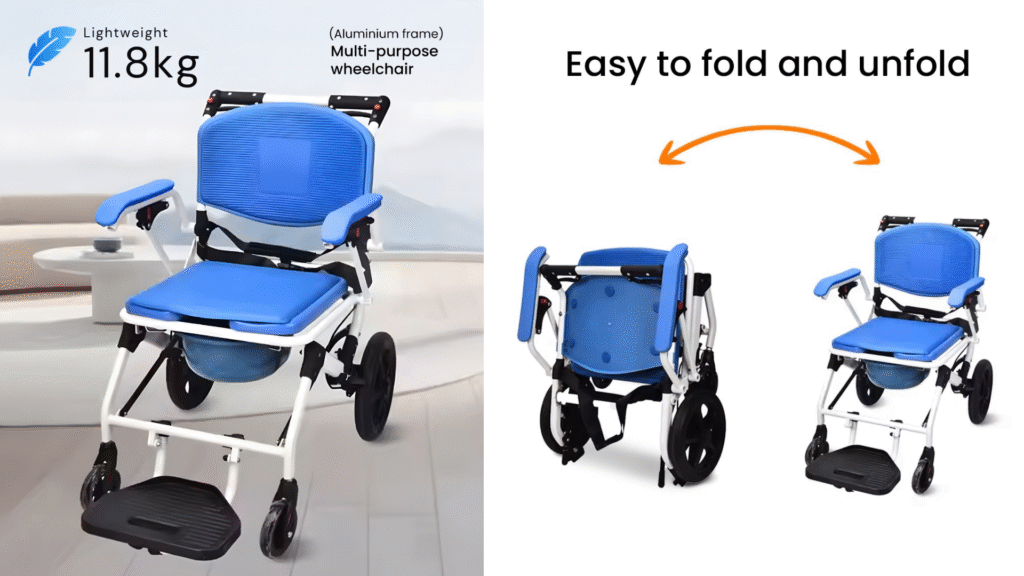Introduction: Why Wheelchair Commodes Are Essential
For many people living with limited mobility, daily hygiene can be one of the biggest challenges. Wheelchair commodes provide a safe and supportive way to manage toileting needs without sacrificing comfort, dignity, or independence. Whether at home or on the move, the right wheelchair commode can make care routines easier for both users and carers.
What Is a Wheelchair Commode?
A wheelchair commode combines the functions of a standard wheelchair with a built-in commode seat. Unlike a regular commode chair, which is usually stationary, wheelchair commodes allow users to be moved between rooms or positioned over a toilet or in a shower area.
Benefits for elderly and disabled users include:
- Greater independence in daily routines
- Reduced strain on carers
- Comfortable design suited for extended use
- Versatility for use at home, in aged care, or while travelling
Key Features to Look for in a Wheelchair Commode
When choosing a commode wheelchair, consider the following features to ensure it meets individual needs:
Portability & Foldability: A Foldable Wheelchair Commode is ideal for smaller homes or travel. These models can be folded for storage or transport.
Comfort and Reclining Options: A Reclining Wheelchair Commode provides added comfort, especially for users who need to stay seated for long periods or require extra support.
Durability and Weight Capacity: Look for strong, lightweight frames that can handle daily use and different body weights.
Self-Propelled vs Attendant-Propelled:
Self-propelled commode wheelchairs give users more independence.
Attendant-propelled options are easier for carers to manage.
NDIS Approval & Funding Considerations: Many wheelchair commodes are eligible under NDIS or state funding programs, making them more affordable.
Best Wheelchair Commodes for Home Use
Reclining Wheelchair with Commode: Perfect for long-term care at home. Reclining options reduce pressure and increase comfort.
Self-Propelled Commode Wheelchairs: Best for users who value independence and want more control in daily routines.
Foldable Commode Chair: Compact and space-saving, this option is suitable for smaller homes and apartments.
Best Wheelchair Commodes for Travel Use
Lightweight, Foldable Commodes: Easy to pack into cars, these are highly practical for families who travel or attend appointments.
Compact Wheelchair Commodes: Designed for portability and convenience, these models work well with public transport or short trips.
NDIS and SWEP Funding for Wheelchair Commodes in Victoria
NDIS Approved Commode Wheelchairs: Participants may be able to include a commode wheelchair in their plan under mobility and daily living supports.
SWEP (State-Wide Equipment Program) in Victoria: Eligible users may access subsidies for commode wheelchairs through SWEP, reducing out-of-pocket costs.
Guidance for Occupational Therapists: OTs play a key role in recommending the right commode wheelchair and preparing supporting documentation for funding applications.
How to Choose the Right Wheelchair Commode for You
When selecting a commode wheelchair, consider:
Daily routines and care needs – long-term vs short-term use
Space and transport – foldable models for small homes or frequent travel
Mobility – self-propelled for independence, attendant-propelled for carer support
Funding options – NDIS and SWEP pathways for affordable solutions
For personalised recommendations, you can submit a product enquiry or contact our team.
Conclusion: Finding the Right Commode Wheelchair for Comfort and Independence
Wheelchair commodes are an essential mobility aid for many Australians, offering safety, dignity, and convenience. Whether you need a reclining model for home use or a foldable option for travel, choosing the right design ensures better care outcomes. With NDIS and SWEP support available, high-quality commode wheelchairs are more accessible than ever.
Browse Our Store for more mobility solutions
Submit a Product Enquiry for tailored advice
Contact Us for NDIS funding support
FAQs
What is the difference between a commode chair and a wheelchair commode?
A commode chair is a stationary toilet aid, while a wheelchair commode combines mobility with toileting support, making it more versatile.
Can I get NDIS funding for a wheelchair commode?
Yes. Many commode wheelchairs are NDIS-approved, but you will need an occupational therapist assessment and supporting documents.
Are wheelchair commodes suitable for shower use?
Some models, known as shower commode wheelchairs, are water-resistant and designed for safe bathroom use.
Which wheelchair commode is best for travel?
A foldable wheelchair commode is best for travel as it can be packed easily into a car or stored in small spaces.
What is the weight capacity of most wheelchair commodes?
It varies by model, but most high-quality commode wheelchairs support between 100–150kg. Heavy-duty options are available for higher capacities.
How do I know if I need a self-propelled or attendant-propelled commode wheelchair?
If the user has upper body strength and wants independence, self-propelled is ideal. If a carer will provide most support, attendant-propelled may be more suitable.



